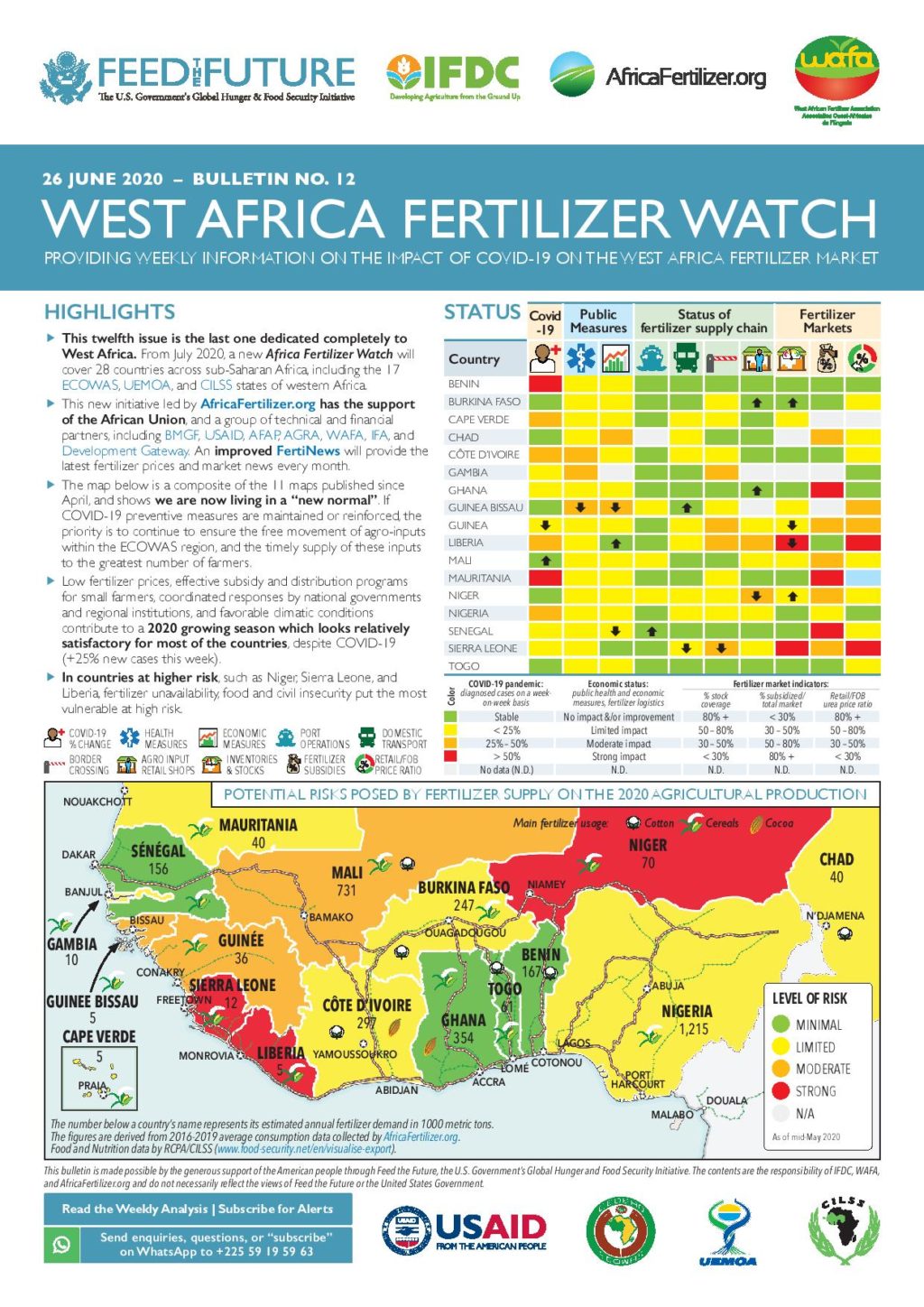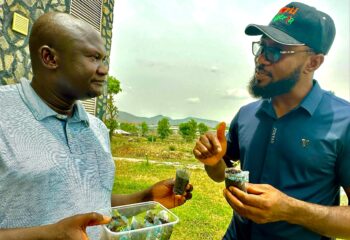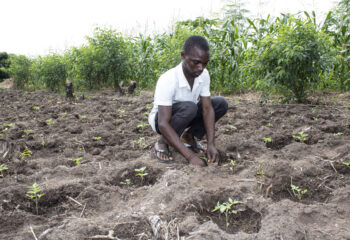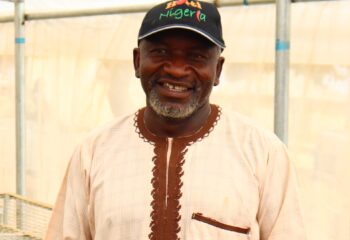
Jump to previous issues
Due to the rapid spread of the novel coronavirus (COVID-19), governments all over the globe have placed restrictions on various forms of travel and trade. In many nations in Africa, where rates of food insecurity and malnutrition remain high, a prolonged restriction on the import and distribution of agricultural inputs could have profound negative impact on food production, which could cause a hunger crisis in addition to a sanitary one.
What is the West Africa Fertilizer Watch?
IFDC, WAFA, and AfricaFertilizer.org are working to ensure that fertilizers and other agricultural inputs are not limited, but rather supported, by governments’ decisions, so that they can continue to reach farmers in time for the growing season. This initiative is supported by the Economic Community of West African States (ECOWAS), the West African Economic and Monetary Union (UEMOA), the Permanent Interstate Committee for drought control in the Sahel (CILSS), and the United States Agency for International Development (USAID).
The Fertilizer Watch is designed to provide weekly updates to stakeholders throughout ECOWAS countries, including Chad and Mauritania, using data collected around 10 indicators. These indicators are related to a variety of information such as the spread of COVID-19, measures taken by country governments, and logistical constraints that affect fertilizer flows. The goal is a well-informed and prepared fertilizer supply chain, where actors can use the information to plan accordingly and ensure consistent delivery to farmers.
IFDC also publishes a bi-weekly Fertilizer Watch for East and Southern Africa.
Current Highlights
Published Friday, June 26, 2020
- This twelfth issue is the last one dedicated completely to West Africa. From July 2020, a new Africa Fertilizer Watch will cover 28 countries across sub-Saharan Africa, including the 17 Western countries, ECOWAS, UEMOA, and CILSS.
- This new initiative led by AfricaFertilizer.org has the support of the African Union, and a group of technical and financial partners, including BMGF, USAID, AFAP, AGRA, WAFA, IFA, and Development Gateway. An improved FertiNews will provide every month the latest fertilizer prices and market news.
- The map below is a composite of the 11 maps published since April, and shows we are now living a “new normal”. If COVID-19 preventive measures are maintained or reinforced, the priority is to continue to ensure the free movement of agro-inputs within the ECOWAS region, and the timely supply of these inputs to the greatest number of farmers.
- Low fertilizer prices, effective subsidy and distribution programs for small farmers, coordinated responses by national governments and regional institutions, and favorable climatic conditions contribute to a 2020 growing season which looks relatively satisfactory for most of the countries, despite COVID-19 (+25% new cases this week).
- In countries at higher risk, such as Niger, Sierra Leone, and Liberia, fertilizer unavailability, food and civil insecurity put the most vulnerable at high risks.
Faits Marquants
- Ceci est le dernier numéro dédié à l’Afrique de l’Ouest. A partir de juillet 2020, l’Observatoire des Engrais en Afrique couvrira 28 pays d’Afrique sub-Saharienne, dont les 17 pays ouest africains, la CEDEAO, de l‘UEMOA et du CILSS.
- Menée par AfricaFertilizer.org, cette initiative a le soutien de l’Union Africaine, et de partenaires tels que BMGF, WAFA, USAID, AFAP, AGRA, IFA, et Development Gateway. Chaque mois, ActuEngrais apportera les dernières informations sur les marchés et les prix des engrais.
- La carte ci-dessous est une synthèse des 11 cartes publiées depuis début Avril et montre que nous sommes rentrés dans une « nouvelle normalité ». Si les mesures préventives sont maintenues ou renforcées, la priorité est de continuer d’assurer la libre circulation des biens et des marchandises dans l’espace CEDEAO, et un approvisionnement en intrants au plus grand nombre de producteurs.
- Des prix des engrais bas, des programmes de subvention et de distribution aux petits paysans en place, des réponses coordonnées des Etats et des institutions régionales, et des conditions climatiques favorables contribuent à une campagne agricole 2020 qui s’annonce relativement satisfaisante pour la majorité des pays de la région, malgré la COVID-19 (+25% de cas cette semaine).
- On surveillera les pays à risques plus élevés (Niger, Sierra Leone, Liberia), l’indisponibilité des engrais, les conditions de sécurité alimentaires et sécuritaires affectent d’abord les plus vulnérables.
Weekly Update #1 – April 10, 2020
Weekly Update #2 – April 17, 2020
- West Africa Fertilizer Watch: Weekly Update #2 (EN)
- Observatoire des Engrais en Afrique de l’Ouest: Bulletin Hebdomadaire #2 (FR)
Weekly Update #3 – April 24, 2020
- West Africa Fertilizer Watch: Weekly Update #3 (EN)
- Observatoire des Engrais en Afrique de l’Ouest: Bulletin Hebdomadaire #3 (FR)
- West Africa Fertilizer Watch – Weekly Analysis #3 (EN)
- Observatoire des Engrais en Afrique de l’Ouest – Analyse #3 (FR)
Weekly Update #4 – May 1, 2020
- West Africa Fertilizer Watch: Weekly Update #4 (EN)
- Observatoire des Engrais en Afrique de l’Ouest: Bulletin Hebdomadaire #4 (FR)
- West Africa Fertilizer Watch – Weekly Analysis #4 (EN)
- Observatoire des Engrais en Afrique de l’Ouest – Analyse #4 (FR)
Weekly Update #5 – May 8, 2020
- West Africa Fertilizer Watch: Weekly Update #5 (EN)
- Observatoire des Engrais en Afrique de l’Ouest: Bulletin Hebdomadaire #5 (FR)
- West Africa Fertilizer Watch – Weekly Analysis #5 (EN)
- Observatoire des Engrais en Afrique de l’Ouest – Analyse #5 (FR)
Weekly Update #6 – May 15, 2020
- West Africa Fertilizer Watch: Weekly Update #6 (EN)
- Observatoire des Engrais en Afrique de l’Ouest: Bulletin Hebdomadaire #6 (FR)
- West Africa Fertilizer Watch – Weekly Analysis #6 (EN)
- Observatoire des Engrais en Afrique de l’Ouest – Analyse #6 (FR)
Weekly Update #7 – May 22, 2020
- West Africa Fertilizer Watch: Weekly Update #7 (EN)
- Observatoire des Engrais en Afrique de l’Ouest: Bulletin Hebdomadaire #7 (FR)
Weekly Update #8 – May 29, 2020
- West Africa Fertilizer Watch: Weekly Update #8 (EN)
- Observatoire des Engrais en Afrique de l’Ouest: Bulletin Hebdomadaire #8 (FR)
- West Africa Fertilizer Watch – Weekly Analysis #8 (EN)
- Observatoire des Engrais en Afrique de l’Ouest – Analyse #8 (FR)
Weekly Update #9 – June 5, 2020
- West Africa Fertilizer Watch: Weekly Update #9 (EN)
- Observatoire des Engrais en Afrique de l’Ouest: Bulletin Hebdomadaire #9 (FR)
- West Africa Fertilizer Watch – Weekly Analysis #9 (EN)
- Observatoire des Engrais en Afrique de l’Ouest – Analyse #9 (FR)
Weekly Update #10 – June 12, 2020
- West Africa Fertilizer Watch: Weekly Update #10 (EN)
- Observatoire des Engrais en Afrique de l’Ouest: Bulletin Hebdomadaire #10 (FR)
- West Africa Fertilizer Watch – Weekly Analysis #10 (EN)
- Observatoire des Engrais en Afrique de l’Ouest – Analyse #10 (FR)
Weekly Update #11 – June 19, 2020
- West Africa Fertilizer Watch: Weekly Update #11 (EN)
- Observatoire des Engrais en Afrique de l’Ouest: Bulletin Hebdomadaire #11 (FR)
- West Africa Fertilizer Watch – Weekly Analysis #11 (EN)
- Observatoire des Engrais en Afrique de l’Ouest – Analyse #11 (FR)
Weekly Update #12 – June 26, 2020
- West Africa Fertilizer Watch: Weekly Update #12 (EN)
- Observatoire des Engrais en Afrique de l’Ouest: Bulletin Hebdomadaire #12 (FR)
- West Africa Fertilizer Watch – Weekly Analysis #12 (EN)
- Observatoire des Engrais en Afrique de l’Ouest – Analyse #12 (FR)



